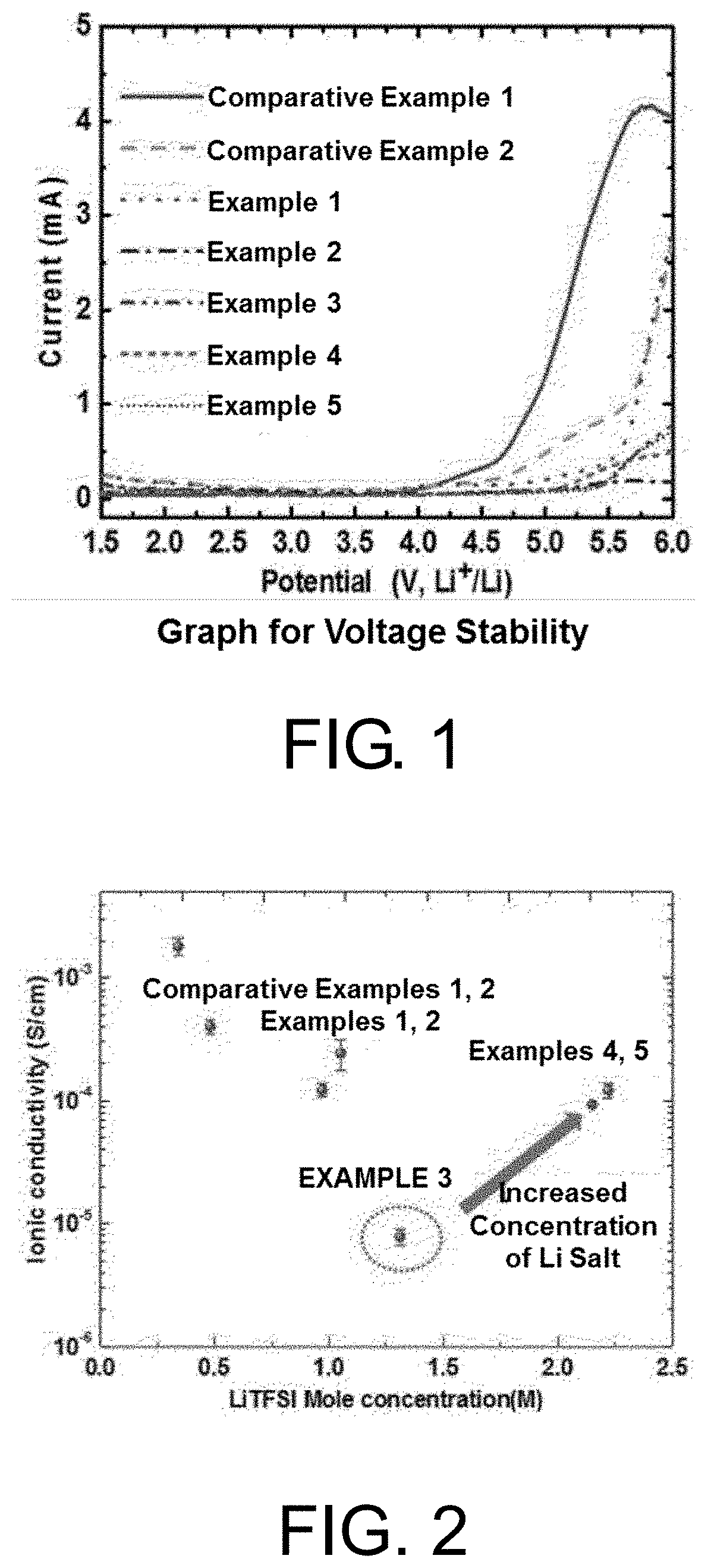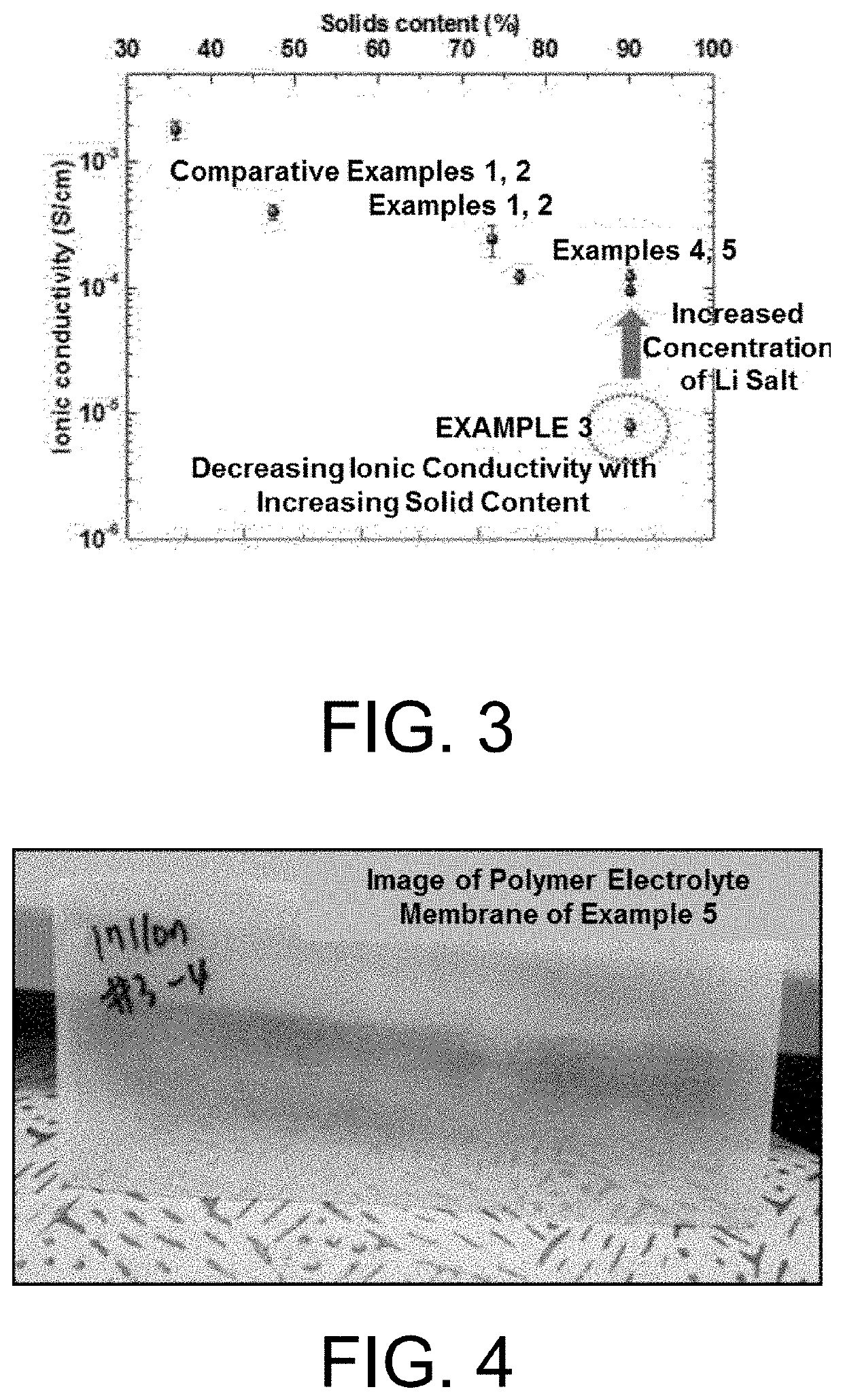Solid electrolyte, method for preparing same, and all-solid battery comprising same
a technology of solid electrolyte and all-solid battery, which is applied in the direction of electrochemical generators, secondary cells servicing/maintenance, non-aqueous electrolytes, etc., can solve the problems of low ionic conductivity, low mechanical stability, and low efficiency of solid electrolyte, so as to improve ionic conductivity and improve mechanical stability , the effect of effective application
- Summary
- Abstract
- Description
- Claims
- Application Information
AI Technical Summary
Benefits of technology
Problems solved by technology
Method used
Image
Examples
experimental example 1
Stability
[0106]The voltage stability of the solid polymer electrolytes manufactured in Examples 1 to 5 and Comparative Examples 1 and 2 was evaluated using linear sweep voltammetry (LSV) and VMP3 commercially available from BioLogic was used. One surface of each of the electrolytes of Examples and Comparative Examples was in contact with a lithium metal electrode and the other surface was in contact with a SUS substrate to manufacture a coin cell. In this case, the cells were measured in a voltage range of 1.5 V to 6.0 V at a scan rage 10 mV / s.
[0107]As shown in FIG. 1, it was confirmed that the electrolytes of Examples exhibited stable characteristics at a high voltage of 5.0 V or more, compared to the electrolytes of Comparative Examples.
experimental example 2
nductivity
[0108]After the impedance of the electrolytes manufactured in Example 1 to 5 and Comparative Examples 1 and 2 was measured, the ionic conductivity of the electrolytes was calculated using Equation 1 below.
[0109]A film sample of the polymer solid electrolyte having a predetermined wide and thickness was prepared for measurements. As an ion blocking electrode, a SUS substrate having excellent electronic conductivity was in contact with both surfaces of a planar sample, and an alternating current voltage was applied through electrodes on both surfaces of the sample. In this case, a measurement frequency was set to an amplitude range of 1.0 MHz to 0.1 Hz and the impedance was measured under applied conditions using VMP3 commercially available from BioLogic. The resistance of the bulky electrolyte was calculated from a point of intersection (Rb) at which a semicircle or straight line of the measured impedance locus comes in contact with the real-number axis, and the ionic condu...
experimental example 3
tardant Property
[0122]To check a flame retardant property of the electrolyte according to the present invention, samples of the respective components and circular samples of the electrolytes manufactured in Comparative Examples and Examples, which had a diameter size of 2 cm, were prepared. Each of the samples was burned using a torch and then checked for flame retardant properties. FIG. 5 shows the results of comparing the flame retardant properties of the respective components included in the electrolyte according to the present invention and FIG. 6 shows the results of comparing the flame retardant properties of the electrolytes manufactured in the comparative examples and examples.
[0123]Referring to FIGS. 5 and 6, it can be seen that the non-aqueous solvent according to the present invention showed characteristics such as steam generation and combustion with fire even when there was a difference in time, and that the ETPTA oligomer, PEO, and LiTFSI showed flame retardant propert...
PUM
| Property | Measurement | Unit |
|---|---|---|
| Temperature | aaaaa | aaaaa |
| Temperature | aaaaa | aaaaa |
| Percent by mass | aaaaa | aaaaa |
Abstract
Description
Claims
Application Information
 Login to View More
Login to View More - R&D
- Intellectual Property
- Life Sciences
- Materials
- Tech Scout
- Unparalleled Data Quality
- Higher Quality Content
- 60% Fewer Hallucinations
Browse by: Latest US Patents, China's latest patents, Technical Efficacy Thesaurus, Application Domain, Technology Topic, Popular Technical Reports.
© 2025 PatSnap. All rights reserved.Legal|Privacy policy|Modern Slavery Act Transparency Statement|Sitemap|About US| Contact US: help@patsnap.com



